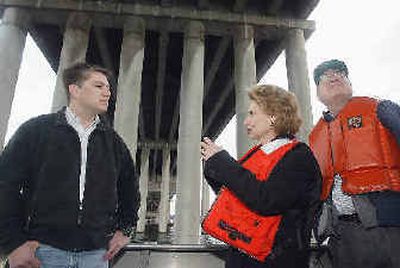State gas tax may rise

OLYMPIA – Two years after adding a nickel to the state’s gas tax, Washington lawmakers are considering a larger, longer-term increase aimed at some of the state’s most serious transportation worries, including two multibillion-dollar Seattle “mega-projects.”
The Senate is considering a 15-cent increase, phased in over 12 years, according to transportation committee members. The $8 billion plan – which was still in flux late Thursday – would start with a 3-cent increase this year, 2 cents next year, and a penny a year for the following decade.
“I’m not sure I would say it’s got more than a 50 percent chance of happening,” said Sen. Brad Benson, R-Spokane. “I think there’s going to be a little bit of a sticker-shock problem.”
In the House, lawmakers have been discussing a 10-cent increase over 10 years, according to Rep. Alex Wood, D-Spokane. The current tax is 28 cents per gallon.
Democrats have a majority in both houses, but leaders in both the House and Senate say they’re counting on at least some Republican votes to make the tax increase a bipartisan measure. That’s proving difficult so far, at least in the House, Wood said.
“We need Republican votes, and I don’t see them now,” he said.
In both plans, much of the money raised would go toward the state’s two largest transportation headaches: replacing Seattle’s Eisenhower-era Alaskan Way viaduct and the nearby State Route 520 floating bridge across Lake Washington.
In the current draft, Benson said Thursday night, about $5 billion of the Senate plan’s $8 billion would be devoted to those projects. That works out to $833 for every man, woman and child in Washington. Benson said much of that $5 billion, however, could be contingent on Seattle-area taxpayers raising additional dollars through local taxes.
Both plans include more money for Spokane’s North-South Freeway, a decades-in-the-making project that’s still in its early phases. Sen. Mary Margaret Haugen, chairwoman of the Senate Transportation Committee, declined through a spokesman to provide additional details on the Senate plan until a news conference scheduled for Monday.
“I think she’s going to have trouble getting Eastern Washington votes for that kind of a package,” predicted Rep. Lynn Schindler, R-Otis Orchards. “That’s a lot of money.”
Both the large Seattle projects are critical, according to state transportation engineers.
The Alaskan Way viaduct was built in the early 1950s as an industrial corridor connecting Seattle’s port and industrial piers with the rail yards to the north in Ballard. A double-decker elevated highway on concrete supports, the viaduct has been considered a problem spot in an earthquake since the 1990s.
Much of it is built on fill dirt and sawdust washed down toward the waterfront during Seattle’s frontier days, when engineers used high-pressure hoses to blast away many of the hills that impeded construction in the growing town. Much of Seattle’s waterfront and historic neighborhoods are built on that fill.
The fill is held in place by the Seattle seawall, a concrete-faced structure built between 1915 and 1936. The seawall, however, is supported by a thick network of timber pilings. According to Department of Transportation studies, about half of those pilings have been weakened by age, earthquakes and decades of boring by wood-eating marine crustaceans called gribbles.
If the Seattle area was hit with an earthquake similar to 2001’s Nisqually earthquake – which was centered near Olympia – the seawall would fail, according to the department. That could wreak havoc with the viaduct, natural gas lines, communications, electricity and local buildings. It could take years to rebuild, Wood said, and the state could face horrific lawsuits.
Replacing the viaduct with an earthquake-resistant version would cost $2.7 billion to $3.1 billion, according to DOT spokesman John Higgins. A preferred option is to build a six-lane tunnel under the downtown waterfront, with the tunnel wall serving as a new seawall. Cost: $3.4 billion to $4.1 billion.
The other big-ticket project is replacing the State Route 520 floating bridge, built from 1960 to 1963. Winter waves have cracked some of the 30-foot concrete pontoons the bridge rests on, but the bigger worry is the construction of the concrete columns supporting each end of the bridge, according to Higgins.
“They were built hollow,” he said, like giant concrete soda cans. Six years ago a barge struck one, closing the bridge for days. Those hollow columns aren’t built to modern earthquake standards, he said. The bridge – the longest floating bridge in the world – handles more than 100,000 vehicles a day. It’s a critical link, he said, between Seattle and growing eastern urban areas such as Bellevue and Redmond.
Replacing the four-lane bridge with a slightly wider version with a bike lane would cost $1.7 billion to $2 billion. A six-lane version would cost $2.6 billion to $2.9 billion.